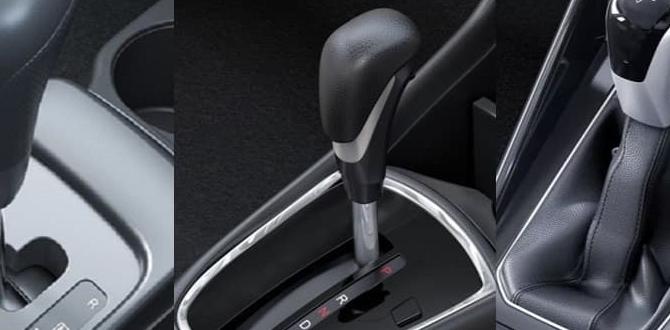TIALN Ball Nose End Mill 35 Degree: Essential Bronze Profiling
The TIALN ball nose end mill with a 35-degree angle is perfect for profiling bronze. It offers excellent durability and heat resistance, making it a go-to tool for achieving smooth, precise finishes on this softer yet sometimes tricky material. Learn why it’s essential for bronze work and how to use it effectively.
Hey there, fellow makers and machinists! Daniel Bates here from Lathe Hub. Ever found yourself wrestling with your bronze parts, trying to get that perfect curved edge or smooth contour? It can be a bit frustrating, right? Well, you’re not alone. Many beginners find profiling bronze a bit challenging, especially getting a clean cut without chewing up the material or the tool. But don’t worry, because the right tool can make all the difference. Today, we’re going to dive deep into the world of the TIALN ball nose end mill with a 35-degree helix angle. It’s a real workhorse for bronze, and once you understand why, you’ll be profiling like a pro. Stick around, and we’ll break down exactly why this tool is so special and how you can use it to achieve those stunning bronze finishes you’re after.
Why the TIALN Ball Nose End Mill is Your Bronze Profiling Best Friend
So, what makes this specific end mill so good for bronze? It all comes down to a few key features that work together beautifully. Bronze, while not as tough as steel, has its own set of properties that can make it gummy and prone to tearing if the wrong tool is used.
Here’s why the TIALN ball nose end mill with a 35-degree helix angle shines when it comes to bronze profiling:
TIALN Coating: This is a game-changer. TIALN stands for Titanium Aluminum Nitride. It’s a super-hard coating that’s applied to the cutting tool. For bronze, this coating is invaluable because it:
Increases Hardness: It makes the cutting edge much harder, allowing it to slice through bronze more cleanly.
Reduces Friction: The coating is incredibly smooth, which significantly lowers the friction between the tool and the bronze. Less friction means less heat and less chance of the bronze material welding itself to the cutter (which is a common problem with gummy materials).
Improves Heat Resistance: Bronze machining can generate heat. TIALN can withstand higher temperatures than uncoated tools, meaning your end mill will last longer and perform better, even under continuous use.
Extends Tool Life: All these benefits combined mean your TIALN-coated end mill will just keep going, giving you more cuts and better results over time.
Ball Nose Shape: The “ball nose” part means the cutting tip is rounded, like half of a sphere. This is crucial for profiling because:
Curved Surfaces: It’s designed to create smooth, concave, or convex surfaces. This is exactly what you need for making fillets, rounded edges, and complex contoured shapes in bronze.
Gentle Entry: The rounded tip allows for a smoother entry into the material compared to a flat-bottomed end mill, reducing shock and chatter, especially in softer metals.
35-Degree Helix Angle: The helix angle is the angle of the flutes (the spiral grooves on the end mill). A 35-degree angle is often considered a “general-purpose” angle, but it hits a sweet spot for profiling softer to medium-hard materials like bronze:
Good Chip Evacuation: It helps to efficiently clear chips away from the cutting zone. This is vital with bronze, which can produce long, stringy chips that tend to recede back into the cut and cause problems.
Smooth Cutting Action: It provides a balanced cut, offering good shear action for efficient material removal while also ensuring a smooth surface finish. It’s not as aggressive as a lower helix angle, nor as gentle as a higher one, making it ideal for controlled profiling.
Reduces Chatter: This angle contributes to a more stable cut, minimizing vibration and the resulting rough surfaces.
When these three features – the TIALN coating, the ball nose geometry, and the 35-degree helix angle – come together in one end mill, you get a tool that’s perfectly engineered for the nuances of profiling bronze. It can handle the material’s tendency to be sticky, remove chips effectively, and leave behind a beautiful, smooth finish.
Understanding Bronze: Why it Needs Special Attention
Bronze is a fascinating alloy, typically made of copper and tin. It’s known for its durability, corrosion resistance, and attractive appearance, making it a popular choice for artistic pieces, decorative components, and even some mechanical parts. However, when it comes to machining, bronze can be a bit of a diva.
Here’s a quick look at why bronze requires a careful approach:
Gummy Nature: As mentioned, bronze can be quite “gummy.” This means it has a tendency to stick to cutting tools, leading to built-up edges. This buildup can cause poor surface finish, increased heat, and eventually damage the cutting tool.
Variable Hardness: The exact composition of a bronze alloy can vary widely. Some bronzes are relatively soft, while others are significantly harder. This means a “one size fits all” approach to tooling and machining parameters might not always work perfectly.
Heat Generation: Like many copper alloys, bronze can generate a considerable amount of heat during machining. Excessive heat can lead to tool wear, poor dimensional accuracy, and a lower quality finish.
Because of these characteristics, using the right cutting tool is paramount. A tool designed to combat stickiness, manage heat, and provide a clean cutting action will make your life infinitely easier and your results far superior. This is where our TIALN ball nose end mill with a 35-degree helix angle truly earns its keep.
Essential Steps for Profiling Bronze with Your TIALN Ball Nose End Mill
Now that we know why this tool is great, let’s get into how you can use it effectively. Following these steps will help you achieve the best results and ensure a safe machining experience.
1. Preparation is Key
Before you even touch the material, a little preparation goes a long way.
Secure Your Workpiece: Make sure your bronze workpiece is clamped extremely securely to your milling machine table or vice. Bronze can be prone to vibration, so a solid setup is non-negotiable. Use parallels if needed for a stable, even grip.
Check Tooling: Inspect your TIALN ball nose end mill for any signs of damage or wear. Ensure it’s properly seated in your collet or tool holder. A loose tool is a recipe for disaster.
Coolant/Lubrication: For bronze, using a cutting fluid or lubricant is highly recommended. It helps to:
Cool the cutting zone, reducing heat.
Lubricate the tool and workpiece, reducing friction and preventing material buildup.
Flush away chips, improving chip evacuation.
A mist coolant system or a good quality cutting fluid for aluminum/copper alloys will work well. You can learn more about choosing the right coolant from resources like the Manufacturing USA guide on metalworking fluids.
2. Setting Up Your Machine
Getting your machine parameters dialed in correctly is vital for a successful cut. These are just starting points; you’ll likely need to adjust them based on your specific machine, the exact bronze alloy, and the size of your end mill.
Spindle Speed (RPM): For a TIALN ball nose end mill profiling bronze, a moderate to high spindle speed usually works best. Lower speeds can lead to rubbing and heat, while very high speeds might become inefficient.
General Recommendation: Start around 6,000 – 12,000 RPM, but always consult your end mill manufacturer’s recommendations if available.
Feed Rate (IPM or mm/min): This is how fast the tool moves into the material. For bronze, a slightly faster feed rate than you might use for steel can sometimes help prevent rubbing and aid chip formation.
General Recommendation: Aim for around 0.001 – 0.003 inches per tooth (ipt) depending on the diameter of your end mill and the depth of cut.
Depth of Cut (DOC): For profiling, you’ll typically be taking shallow to moderate cuts.
General Recommendation: For finishing passes, keep the DOC very shallow (e.g., 0.010 – 0.020 inches). For roughing passes, you might go deeper, but always ensure your machine and tool can handle it without excessive chatter.
Stepover: This is how much the tool moves sideways between passes. For profiling, this is often dictated by the tool diameter and desired surface finish.
General Recommendation: For smooth, continuous profiling, a stepover of 50-75% of the tool diameter is common. For intricate details or very fine finishes, you might reduce this.
Table: Starting Parameter Recommendations for 35-Degree TIALN Ball Nose End Mill on Bronze
| Parameter | Typical Range (for small to medium end mills) | Notes |
| :————— | :——————————————- | :————————————————————————————————————————– |
| Spindle Speed | 6,000 – 12,000 RPM | Adjust based on tool size and desired finish. Higher speeds often required for smaller diameters. |
| Feed Rate (ipt) | 0.001 – 0.003 inches per tooth | Balance chip load to avoid rubbing. Increase with larger tool diameters or harder bronzes. |
| Depth of Cut | 0.010 – 0.050 inches | Lighter cuts for finishing, deeper for roughing. Always prioritize stability and surface finish over speed. |
| Stepover | 50% – 75% of tool diameter | Can be adjusted for surface finish requirements. Smaller stepover for smoother surfaces. |
| Coolant/Lubricant| Essential | Use flood, mist, or appropriate cutting fluid for copper alloys to manage heat and reduce friction. |
Note: These are general guidelines. Always refer to your cutting tool manufacturer’s recommendations and perform test cuts on scrap material if possible.
3. Executing the Profiling Cut
Once everything is set up, it’s time to make the cut.
Setting the Zero Point: Accurately set your machine’s zero point (X, Y, and Z axes) relative to your workpiece. For accurate profiling, using a touch probe or edge finder is ideal.
Plunge or Ramp In: If you need to plunge the end mill into the material, do so slowly and with lubricant. Alternatively, if your CAM software or manual programming allows, use a ramping motion (where the tool enters the material at an angle) — this is generally kinder to the tool and machine.
Follow the Path: Program or manually guide the end mill along your desired profile path. Ensure a consistent feed rate.
Listen and Look: Pay attention to the sound of the cut. A smooth, consistent hum is good. Any unusual chattering, squealing, or significant changes in sound might indicate a problem. Watch for excessive chip buildup or signs of the tool rubbing.
Finishing Passes: For the best surface finish, consider taking a final “peel mill” or finishing pass with a very shallow depth of cut and a slightly adjusted feed rate. This pass removes any minor imperfections left by the roughing passes.
4. Post-Machining
Clean Up: Once machining is complete, carefully remove the part and clean off any residual chips and coolant.
Inspect: Examine the profiled surfaces for accuracy, smoothness, and any signs of tool wear.
When to Use What: Ball Nose End Mill Angles Explained
While we’re focusing on the 35-degree angle specifically for bronze, it’s helpful to understand why different helix angles exist and when you might reach for them. The helix angle significantly affects how the cutting tool interacts with the material.
Table: Ball Nose End Mill Helix Angles and Applications
| Helix Angle | Typical Characteristics | Best For |
| :—————– | :————————————————————————————————————————- | :————————————————————————————————————————————————- |
| Low (0-20 deg) | High shear angle, aggressive cut, can be prone to chatter, good for softer metals but can be gummy. | Soft aluminum, plastics, some softer steels where aggressive material removal is prioritized and chatter can be controlled. |
| Medium (25-35 deg)| Balanced cut, good chip evacuation, reduced chatter, good all-round performance. | Bronze, aluminum alloys, mild steels, stainless steels. Excellent for general-purpose profiling and contouring. |
| High (40+ deg) | Very smooth cut, excellent for finishing, reduced radial forces, can be less effective for heavy material removal. | High-finish passes on aluminum, steels, and exotic alloys where surface finish is critical. Can be good for hard materials. |
| Variable Helix | Designs with different helix angles along the flute. Aims to break up harmonic vibrations and reduce chatter further.
| Advanced machining of difficult-to-machine materials and applications where chatter is a persistent problem, even with standard angles. |
Our TIALN ball nose end mill with a 35-degree helix angle sits perfectly in the “medium” category, offering that sweet spot of effective material removal, good chip control, and a smooth finish that’s ideal for bronze.
TIALN vs. Other Coatings
You might wonder why TIALN is specifically recommended. While other coatings exist, TIALN has proven itself time and again for many machining applications, including those involving bronze. Let’s quickly compare TIALN to a couple of other common coatings:
TiN (Titanium Nitride): This is one of the oldest and most common PVD coatings. It’s gold in color, adds some hardness, and reduces friction. It’s good for general-purpose machining but doesn’t offer the same level of heat or wear resistance as TIALN. For sticky materials like bronze, it might not be sufficient to prevent buildup.
TiCN (Titanium Carbonitride): This coating is gray/black and harder than TiN. It offers better abrasion resistance, making it suitable for harder materials and abrasive conditions. However, its heat resistance is lower than TIALN.
ZrN (Zirconium Nitride): This coating is gray/silver. It’s known for its excellent lubricity and is often used for aluminum and plastics. It can be a good option, but TIALN often provides a more robust combination of hardness, lubricity, and heat resistance suitable for demanding bronze applications.
AlTiN (Aluminum Titanium Nitride): This is another high-performance coating, often black or dark purple. It offers excellent high-temperature performance and is very popular for machining steels and superalloys. While it can be used on bronze, it’s often overkill and TIALN’s specific properties are frequently a better fit for the “gummy” nature of copper alloys.
For profiling bronze, the combination of TIALN’s hardness, its ability to resist built-up edge (BUE), and its excellent thermal stability makes it the preferred choice for many machinists. It balances the need for a sharp, durable edge with the challenges presented by bronze’s inherent stickiness.
Troubleshooting Common Issues
Even with the right tools, machining can present challenges. Here are a few common issues you might encounter when profiling bronze and how the TIALN 35-degree ball nose end mill can help.
Poor Surface Finish (Roughness/Chatter):
Cause: Insufficient rigidity in workpiece or machine, incorrect feed rate or spindle speed, dull tool, or inadequate chip evacuation.
Solution: Ensure workpiece is rigidly fixtured. Check and adjust your cutting parameters – a slightly faster feed rate might help. Ensure your end mill is sharp. Use coolant to improve chip evacuation. The 35-degree helix angle is designed to reduce chatter, so if it’s occurring, re-evaluate your setup and parameters carefully.
Material Buildup on Cutter (Galling):
Cause: Low spindle speed, insufficient feed rate, lack of lubrication, or using a less-than-ideal coating.
Solution: Increase spindle speed. Ensure you’re using an adequate feed rate. Crucially, use plenty of correct coolant or lubricant. The TIALN coating is specifically designed to minimize this issue by reducing friction and resisting adhesion. If you’re still experiencing buildup, try a dedicated lubricant for copper alloys.
Tool Breakage:
Cause: Excessive depth of cut, plunging straight into the material too aggressively, tool chatter, or a worn-out tool.
Solution: Reduce depth of cut. Use ramp entries or shallow plunges. Ensure your machine and workholding are rigid. Regularly inspect your tool for wear. The durability of the TIALN coating helps extend tool life, but no tool is indestructible! Always err on the side of caution with depth of cut.
Frequently Asked Questions (FAQ)
What is a TIALN coating?
TIALN stands for Titanium Aluminum Nitride. It’s a thin, hard coating applied to cutting tools that increases their wear resistance, reduces friction, and improves their ability to withstand heat during machining. This makes tools last longer and perform better, especially on tougher materials or when high-speed machining.







